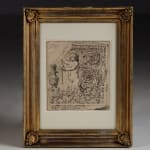Pen and Ink Drawing
Pen and Ink Drawing after the Villa Albani Marble Relief
Italian, 18th Century
Presented in an antique carved and water-gilded Roman frame.
Height: 38cm Width: 6.5cm Depth: 7.5cm
This finely worked pen and ink drawing records a Roman marble relief from the Villa Albani, Rome. The relief, depicting winged sea-creatures flanking a central candelabrum, was among the celebrated antiquities collected for Cardinal Alessandro Albani in the 18th century.
Comparison with surviving marble demonstrates that the drawing was made prior to later restoration, preserving details that were subsequently altered. While no published source precisely dates the restoration of this relief, the acquisition of the Albani collection by the Torlonia family in 1866 marked the beginning of systematic conservation and interventions. The drawing therefore provides valuable evidence of the work's earlier state, likely dating to the late 18th or early 19th century.
Presented in an antique carved and water-gilded Roman frame, the drawing captures the sculptural detail with particularly sensitivity, from the flowing tails of the figures to the intricate acanthus scrolls framing the composition.
Italian, 18th Century
Presented in an antique carved and water-gilded Roman frame.
Height: 38cm Width: 6.5cm Depth: 7.5cm
This finely worked pen and ink drawing records a Roman marble relief from the Villa Albani, Rome. The relief, depicting winged sea-creatures flanking a central candelabrum, was among the celebrated antiquities collected for Cardinal Alessandro Albani in the 18th century.
Comparison with surviving marble demonstrates that the drawing was made prior to later restoration, preserving details that were subsequently altered. While no published source precisely dates the restoration of this relief, the acquisition of the Albani collection by the Torlonia family in 1866 marked the beginning of systematic conservation and interventions. The drawing therefore provides valuable evidence of the work's earlier state, likely dating to the late 18th or early 19th century.
Presented in an antique carved and water-gilded Roman frame, the drawing captures the sculptural detail with particularly sensitivity, from the flowing tails of the figures to the intricate acanthus scrolls framing the composition.



